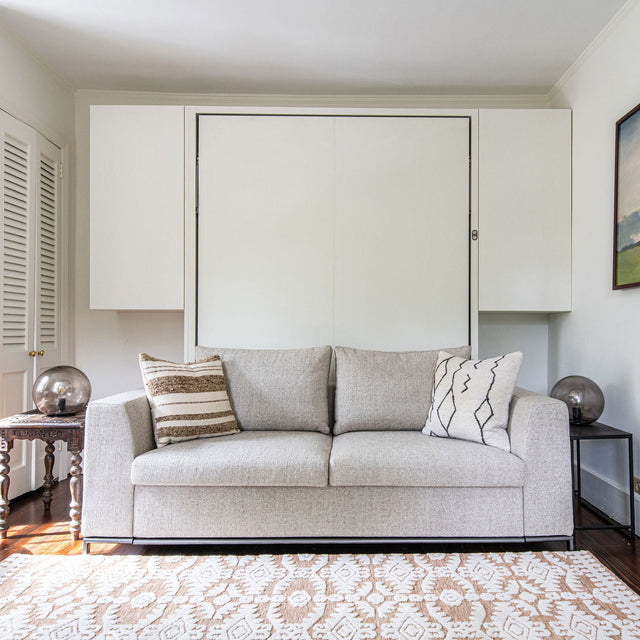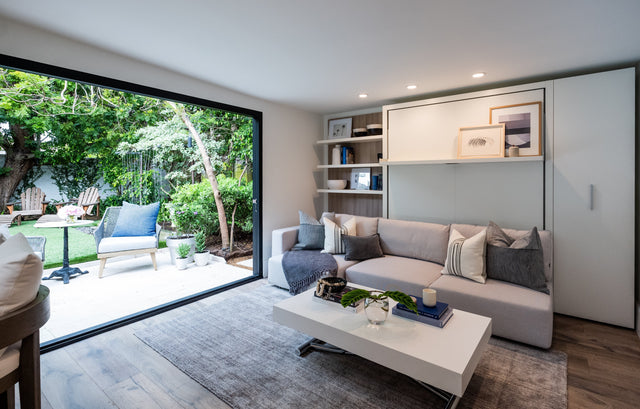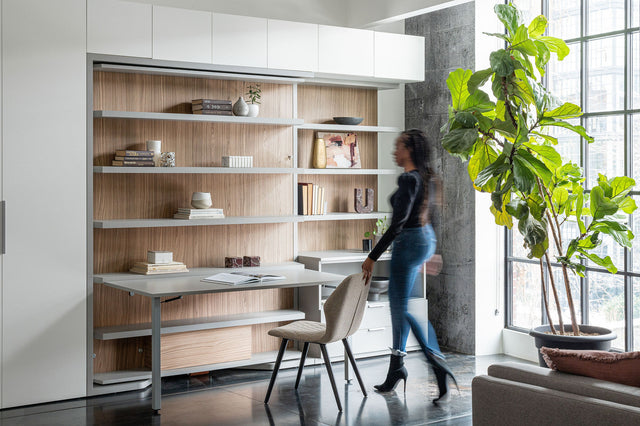What Is a Modular Home? The Future of Flexible, Design-Forward Living
 The next generation of modular homes are defined by luxurious, adaptable interiors: A Los Angeles prefab home’s living room transforms effortlessly from day to night with a sofa wall bed by Resource Furniture.
The next generation of modular homes are defined by luxurious, adaptable interiors: A Los Angeles prefab home’s living room transforms effortlessly from day to night with a sofa wall bed by Resource Furniture.
For decades, building a new home has been a slow, expensive process – especially in design-focused cities where time and space come at a premium.
Now, a fresh approach is gaining traction: modular housing. And while the idea of factory-built homes isn’t completely new, today’s modular homes have been reinvented as stylish, efficient dwellings for modern living.
Advances in technology and sustainable design have led to a new era of efficient, flexible living. As demand for more – and more affordable – housing surges, modular homes offer a streamlined way to build.
This prefab approach speeds up construction, cuts down on waste, and delivers high-quality, design-forward results.
At Resource Furniture, modular design is part of our DNA. Our extensive collection of luxury, space-saving furniture helps maximize every square foot of a modular interior without compromising style or comfort.
We believe that great design and smart use of space go hand-in-hand – and modular homes are the perfect showcase of that philosophy.
In this article:
- What Is a Modular Home?
- How Modular Homes Are Built
- Modular vs. Traditional Homes: What’s the Difference?
- The Design Edge: Modular Homes + Modular Furniture
- Customization Options That Maximize Space
- Resale Value & Investment Potential
- Your Modular Home Questions, Answered
- Rethinking “Home” with Flexibility in Mind
What Is a Modular Home?
A modular home is a type of prefabricated (prefab) house that’s built off-site in sections (called modules) and then assembled on a permanent foundation at the final location. This off-site construction process allows modular homes to be completed much faster than a traditional site-built house.
One common misconception is that modular homes are the same as manufactured homes (or mobile homes). In reality, they are quite different. Manufactured homes are built entirely on a steel chassis and delivered as a whole unit, usually sitting on a temporary foundation like concrete piers or pads.
Modular homes, by contrast, are shipped in multiple sections and placed on a permanent foundation. Importantly, modular homes must meet the same local and state building codes as any stick-built home, ensuring they are just as safe and well-constructed.
Manufactured homes follow a different federal code (HUD) and typically do not meet those local building standards. Building houses in a factory setting also brings big benefits. Modular homes are typically 80–90% complete before they even leave the plant, which greatly reduces construction time and material waste at the site.
The controlled factory environment means better quality control – modules aren’t exposed to rain and weather during construction, and precision tools ensure every wall and floor is built to exact standards. The result is often a more durable home with improved energy efficiency and a smaller environmental footprint.
Adding to their appeal, modular homes are fully customizable and often indistinguishable from traditional homes. From sleek contemporary facades and architectural details to high-end finishes and appliances, today’s modular designs offer a wide range of options.
Homebuyers can tailor the floor plan, exterior style, interior layout, and energy-efficient features to suit their taste. With so many choices – and often a lower cost per square foot to build – a modular home makes it possible to achieve a luxurious, tailor-made living space at a more affordable price point.
In other words, you can enjoy a flexible, efficient lifestyle without sacrificing style or quality. Modular homes also come in all sizes – from compact 600-square-foot cottages to spacious 3,000-square-foot family houses.
One especially popular application of modular construction is the accessory dwelling unit (ADU). These small-footprint structures – whether used as a backyard rental cottage, guest house, home office, or in-law suite – benefit greatly from modular building’s efficiency and flexibility. Thanks to their compact size and factory-built construction, ADUs can be completed and installed much faster than a comparable structure built entirely on-site.
In short, a modular ADU can be customized to your needs and ready to use in a fraction of the time of a traditional build.
At Resource Furniture, we’ve helped outfit countless modular ADUs and other small homes with space-saving essentials like wall beds, modular shelving, and transforming tables. Multifunctional furniture is a natural fit for the dual-purpose rooms often found in these dwellings.
By using flexible, transforming designs, homeowners get the most out of every inch – without ever sacrificing luxury or style.
How Modular Homes Are Built
Modular home construction begins in a climate-controlled factory. Inside the factory, skilled craftsmen and advanced machinery fabricate the home’s components – floors, walls, ceilings – with precision.
Once each section (module) is complete, it’s transported to the building site and lifted into place with cranes. There, builders join the modules together and complete the finishing touches on-site, adding things like roofing, siding, and interior fixtures. This off-site building method offers major advantages.
Because much of the work happens in parallel (the foundation can be prepared on your land while the house itself is being built in the factory), overall construction time is significantly shorter.
Quality control is often superior as well, since every piece is built under strict oversight in the factory rather than exposed to the elements for months. There’s also far less disruption to the surrounding neighborhood – shorter construction time means fewer trucks, less noise, and minimal mess on-site.
For homeowners, that all translates to a faster move-in, shorter overall construction time, and a more predictable project timeline.
Modular vs. Traditional Homes: What’s the Difference?
When comparing a modular home vs traditional home, the finished product may look nearly identical, but there are some key differences in how they’re built—and how they perform.
- Construction Time: A modular home can often be completed in about half the time of a traditional site-built home, since on-site preparation and factory construction happen simultaneously.
- Materials and Quality: Modular homes use the same building materials as traditional homes, and they often benefit from stricter factory-controlled quality checks. The result is a home just as sturdy and long-lasting as a conventional build.
- Cost Efficiency: The efficient building process typically makes modular homes more cost-effective. Reduced labor time and less material waste in the factory can save money compared to a similar home built from scratch on-site.
- Foundation: Both modular and stick-built houses rest on permanent foundations. The difference is that a modular home arrives as large pre-built sections that are then assembled on its foundation, whereas a traditional home is built piece-by-piece on site.
- Building Codes: Modular homes must meet the same local and regional building codes as any site-built home. (Manufactured/mobile homes, by comparison, adhere to a federal HUD code, not local codes.)
In the end, the biggest differences between a modular home and a traditional home lie in the construction process and efficiency, not in the overall look or durability of the house.
The Design Edge: Modular Homes + Modular Furniture
Modular homes and modular furniture share a common design philosophy: both emphasize design flexibility, efficiency, and seamless functionality.
Modular homes are often composed of boxy, stacked sections, which naturally lends itself to clean lines and open, multi-purpose interiors. These streamlined layouts aren’t just about squeezing in as much as possible – they’re about using space thoughtfully and intentionally.
Because modular construction maximizes efficiency, many modular homes feature open floor plans and a smaller footprint than a typical house. Making the most of every inch is essential – and that’s where the right furniture can make all the difference.
This is precisely where Resource Furniture’s transforming furniture designs come in. For example, imagine a stylish 500-square-foot modular guest house or city apartment.
By day, it’s an open living area; by night, a wall bed (like the Oslo Sectional) pulls down to convert the living space into a cozy guest bedroom complete with a queen-size bed and built-in storage. A height-adjustable table (such as the Dynamic Table) serves as a coffee table during the day, then rises to become a dining table or a work desk when you need it.
Floor-to-ceiling modular shelving — including transforming shelving options — provides ample storage and a clean, cohesive look. The result is a single elegant space that functions like two or three rooms throughout the day – with furniture that adapts as fluidly as the home itself.
This synergy between factory-built homes and flexible, transformable interiors perfectly embodies the spirit of contemporary design: versatile, sustainable, and tuned to how we live today.
Customization Options That Maximize Space
Even though they’re prefabricated, modular homes are anything but cookie-cutter — today’s designs offer a wide range of customization options that let you tailor every detail to your lifestyle.
In fact, modern modular construction offers an incredible range of choices for personalization. You can customize nearly every detail of your home: choose the floor plan and number of rooms, select your exterior style and siding, pick flooring and cabinetry, and opt for high-end fixtures and appliances that match your taste. You can even incorporate custom built-in cabinets or storage solutions tailored to your needs.
Love the idea of an open-concept kitchen with vaulted ceilings? Prefer eco-friendly materials and smart-home technology? With modular building, it’s all possible – your home can be just as unique and design-forward as a traditional architect-designed house.
Resource Furniture often partners with architects, designers, and homeowners to furnish modular homes for maximum style and functionality. From clever concealed storage systems to convertible sofas and expanding tables, our furniture ensures that no square foot goes to waste.
We frequently design solutions for vacation rentals, ADUs, and compact urban apartments – situations where smart, multipurpose furniture is especially valuable for making a small space live large.
Resale Value & Investment Potential
In the past, prefab homes (including older modular homes) were often undervalued. But today, changing perceptions – along with the rising demand for housing in urban areas – have made modular homes an increasingly attractive investment.
When placed on a permanent foundation and well-maintained, a modern modular home will appreciate in value much like a traditionally built home. Plus, its eco-conscious construction and quick turnaround can be selling points that appeal to a wide range of buyers. Especially in competitive markets like Los Angeles and New York, we’ve seen a steady rise in high-end modular builds.
Design-savvy homeowners are embracing modular homes and pairing them with custom, space-saving furniture to make the most of pricey city lots without sacrificing style.
For investors in vacation properties or homeowners planning for retirement, modular housing offers a blend of flexibility and long-term value. You get a dwelling that can adapt to different needs over time, and you’re making a forward-thinking investment in quality and sustainability.
Your Modular Home Questions, Answered
What is the difference between modular and manufactured homes? Modular homes are built in sections (modules) in a factory and then assembled on a permanent foundation on-site. They must meet the same local building codes as traditional houses.
Manufactured homes, on the other hand, are built on a steel chassis and delivered as a whole unit (typically to sit on a temporary foundation like a concrete pad). Manufactured homes follow a federal HUD building code instead of local building codes.
How long does it take to build a modular home?
Every project is different, but modular homes can often be completed in about half the time of a comparable site-built home. In many cases, a modular home goes from design to move-in within just a few months.
Are modular homes built to the same code as traditional homes?
Yes. Modular homes must meet the same state and local building codes as any traditionally built home. In other words, they are held to the same safety and quality standards as a site-built house.
Can I customize the layout and design of a modular home?
Absolutely. You can customize most aspects of a modular home’s design. That includes choosing your ideal layout, selecting the finishes and fixtures, and even adding special features or built-in furniture.
Modular construction offers a lot of flexibility, so you can create a home tailored to your lifestyle and tastes.
Is a modular home considered “real” property?
Yes. Once it’s assembled on a permanent foundation (on land you own), a modular home is considered real property, just like any conventional stick-built house. It can be bought, sold, and valued the same way a traditional home is.
Do modular homes hold their value over time?
Yes. A well-built modular home will hold its value similarly to a traditional home. With proper maintenance and a good location, it should appreciate over time.
In fact, the precision and quality control of factory construction often give modular homes an edge in durability, which can help protect their long-term value.
Rethinking “Home” with Flexibility in Mind
As the definition of “home” continues to evolve, modular construction – paired with flexible interior design – is leading the way. Prefabricated homes offer the freedom to design smarter, live more compactly, and move faster than ever before.
Paired with adaptable, multi-purpose furniture, they create a harmonious blend of innovation and elegance that suits our modern lifestyle. As we reimagine how and where we live, one thing is clear: the homes of the future won’t just be beautiful – they’ll respond and adapt to our lives.
At Resource Furniture, we’re proud to be part of this exciting transformation.
If you’re ready to optimize your modular home, our expert design team is here to help. Schedule a showroom visit or virtual consultation with a Resource Furniture design consultant today, and let us help bring your vision to life.
Recent Posts

6 Ways to Create a Hotel-Like Guest Room Experience

Aging in Place That Actually Feels Like Home

Does Converting a Garage to a Living Space Add Value? What to Know Before You Start

Multifunctional Kids' Room by YZDA at Armani Casa Miami

When Every Inch Counts: A Multifunctional Retreat in Cobble Hill





